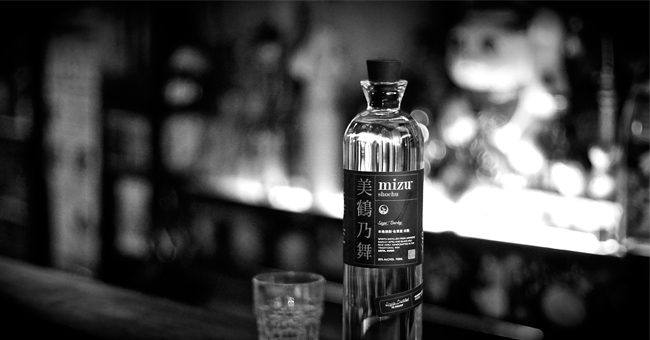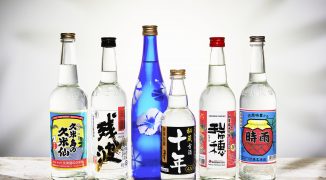Western bartenders may have caught on to shochu in recent years, but don’t be fooled: this Japanese spirit has been around for centuries, and is so widely beloved in Japan, it’s surpassed sake in popularity.
To better understand the history, complexity and nuance of shochu, we asked experts Brian Matthys and Chris Johnson to join us for a live discussion and tasting. Matthys works with shochu regularly at La Chine in New York, and has traveled to Japan multiple times to research the spirit. Johnson, also known as the Sake Ninja, first encountered sake and shochu when teaching English in Japan, and now spreads his knowledge as a sake sommelier and educator. The two set up shop at La Chine inside the Waldorf Astoria and gave us the 101 on shochu (along with tastings from an impressively diverse range of styles). Below, a few of the takeaways:
First of all, a few things shochu isn’t:
It’s not baijiu, which is a Chinese sorghum-based spirit. It’s not sake, which is brewed (not distilled) from rice. It’s not soju, which is made in Korea and typically lower-proof. And it’s definitely not “Japanese vodka,” Matthys and Johnson assure us: the diversity in production styles, base ingredients and resulting flavor palates goes beyond what can be achieved in the vodka category. Which brings us to the next point:
Shochu might be one of the most diverse spirit categories out there.
First of all, there are 50 different base ingredients that can be used in the base production of shochu, Matthys and Johnson tell us — the base can range from rice to sweet potato to roasted barley. Then there’s the addition of koji, the fungus that aids in converting starches to sugar (more on that next). Shochu can also be made with either high-pressure or low-pressure distillation, can be distilled multiple times or just once, and can vary enormously just based on the water used in production. “There are 800-plus distilleries and 5000 different labels — there is lots of diversity,” says Johnson. “It’s not just a base clean alcohol. It can be enjoyed on its own, paired with food and blended into amazing cocktails.”
One of the most interesting aspects of shochu is koji.
This humble but hardworking fungus — which is also responsible for miso and soy sauce — is essential to shochu’s production, and also contributes to the incredibly diverse range of flavors within the category.
“It is an extremely important microorganism in flavor,” says Johnson. “It aids in the saccharification process,” adds Matthys. “So when you’re converting starch to sugar, with barley you’ll malt it, but in the case of Japanese shochu, koji is what takes care of that process.” The three different types used in shochu production (white koji, yellow koji and black koji) each impart very different aromatics and flavors, contributing to the myriad styles and tastes to be found within the category.
The range of resulting flavor profiles can appeal to a lot of different palates and preferences.
Thanks to its diversity, one could argue that there’s a shochu out there for everyone, from those who prefer lighter, restrained and low-ABV to people who like more assertive flavor. Our experts tell us that generally, rice-based shochus can be a great way to go when introducing newbies to the spirit, though “a lot of bartenders tend to geek out and go for the sweet potato shochu, which is another good way to go.” The type of koji used also plays into this: white koji happens to work very well when you’re trying to create a lighter, more aromatic flavor profile, while black koji imparts an unmistakable earthiness. Even the range of flavor represented in our tasting was broad, from a barrel-strength roasted barley shochu with toasty, chocolate aromas to a lighter, more subdued rice-based shochu made with white koji.
As for industry types? “If you were to throw down something like a black koji imo [sweet potato base], really funky and earthy, that might be a tough first pitch. But for the bartenders out there and the somms, they’d probably be cool with it.”
And it works in a lot of different cocktail styles.
“When you talk about options to create the cocktail, it’s truly massive,” says Matthys. “Some [shochus] are whiskey-like, some defy categories. It runs the gamut. You can’t just say ‘I’m putting shochu in this cocktail’ — it’s important exactly which shochu you’re going to put in.” Matthys and Johnson also add that often, the presence of koji will add a touch of umami, which can lend interesting dimension and complexity to cocktails. (It’s also great in a highball.)
From roasted barley to rice to sweet potato, the base can vary, but it’s immediately apparent on the nose.
As you would expect, when you look at the base ingredients, that base comes through quite a bit. Matthys and Johnson say that this is one of the things they both love about shochu, and why we don’t necessarily talk about it as a vodka, which is often described as a colorless, odorless liquid. “This is not that. This has a lot of aroma, it has a lot of flavor profile, and that’s what we like about shochu as an alternative,” says Johnson.
There’s even a version that’s like Japan’s own rhum agricole.
Japan’s version of rhum agricole – sugarcane shochu. Someone might ask, why is this not rum? And the answer, of course, is koji. If it is shochu, it has to be made with koji. It certainly shows through, you get a lot of the tropical notes that you get from different rums.
Lighter shochus are great for low-ABV cocktails and aperitifs.
Aperitifs are definitely having a moment, and Matthys and Johnson both agree that shochu’s ideal for this format. “Aperitif cocktails are certainly en vogue, as well they should be, and this works very well for those,” says Matthys. “[The roasted barley shochu] works wonderfully with vermouth and sherries,” he adds. But, of course, shochu can flex beyond the low-ABV cocktail, too. “I’ve paired or worked with shochus in cocktails with just about everything. With pairing, you’re going to find, with this much diversity, it can work with absolutely everything.”
One of the most interesting yet simple ways to enjoy it: diluted with hot water.
It’s called oyu-wari. Matthys says he encountered this serving style numerous times when he was traveling in Japan, even in the hotter months. “Sometimes it’ll be four parts water to one part spirit. I was thinking that would totally dilute it and blow it out, and the flavor would be gone, and it’s amazing: the flavor is such that it still stands up incredibly well. You can drink it all night.”
Johnson adds that he first learned about oyu-wari when living with a family in Japan. “Grandpa used to enjoy his shochu but always thought he could handle more than he actually could drink. As I was learning, the father would look at me and say, put in less shochu, put in more water, he’ll never notice. The warm water actually really elevates all those aromatics. Most of what you taste, as we know, comes through our nose, so when you do that, you get all this rich flavor even though you’ve watered it down a bit.”
“As we know,” adds Matthys, “if you drink something very chilled, it tends to hide defects and dull things a little bit. In the case here with hot water, it really elevates things and the flavor comes through dramatically.”
Watch the full video here, and if you want to learn more, don’t miss the slideshow from this year’s shochu presentation at Tales of the Cocktail.





